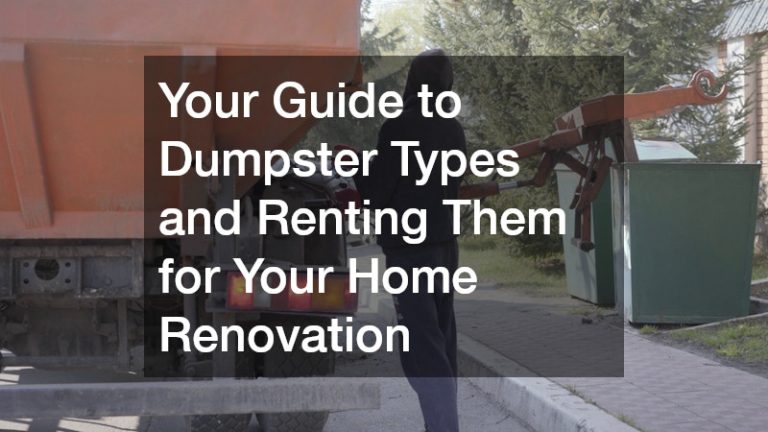Home renovations are exciting, but they also come with a major reality check: dealing with the waste. Whether you’re tearing out old cabinets, ripping up tile floors, or replacing drywall, the debris adds up fast. Without a plan for handling all that refuse, your project can quickly spiral into disorganization, delays, or even costly fines. That’s where understanding your disposal options becomes essential. Knowing what dumpster types are available, which one to choose, and how to properly arrange for one can make the entire renovation experience smoother and far more efficient.
With so many options available, it’s easy to feel overwhelmed about choosing the right bin for your home project. Different container sizes and formats serve different needs—from compact containers suited for small bathroom remodels to large bins perfect for full-scale demolition work. And beyond size, you’ll also want to consider delivery logistics, placement, permit requirements, and even how long you’ll need the container on-site. Having a clear grasp of what to expect can help you sidestep frustration and added costs.
Whether you’re a first-timer or someone with experience, this guide will provide helpful insights and a better understanding of how to approach waste removal. From beginning to end, our focus is on making your renovation cleaner, more organized, and far less stressful. Keep reading to gain the confidence and knowledge you need for a successful project cleanup, starting with a look at why effective waste management is so important.
1. Why Waste Matters
When planning a home renovation, it’s easy to get caught up in choosing paint colors, flooring materials, or layout designs. But one of the most overlooked—and most essential—components of a successful project is having a clear plan for waste management. Piles of wood scraps, broken fixtures, insulation, and even dust can accumulate quickly. Without proper disposal in place, these materials can clutter your space, delay progress, and create hazards for workers or family members. Taking the time to plan how you’ll handle debris can help ensure that your renovation stays organized and on schedule.
One of the most efficient solutions available to homeowners is working with professional dumpster rentals. These services offer convenient delivery and pickup, allowing you to focus on your project without worrying about repeated trips to the local dump. Instead of piling trash in your driveway or backyard, you’ll have a centralized container designed to hold large volumes of waste. Choosing the right option can streamline your renovation and minimize cleanup headaches.
There are several types of dumpsters to choose from, and the one you select will depend on the nature and scale of your renovation. Some are better suited for small jobs, while others are designed for heavy construction materials or large volumes of mixed debris. Understanding the variety of choices early on will help you plan accordingly and avoid underestimating your waste needs. As we move through this guide, you’ll learn which container best matches your goals, your budget, and your space.
2. Sizing It Right

Choosing the right container size is one of the most important decisions you’ll make during your renovation planning. Too small, and you risk overflow and extra fees for multiple hauls. Too large, and you may end up paying for more capacity than you need. Sizing your container accurately not only saves money but also helps your jobsite remain safe and efficient. Size decisions should take into account the type of project, the materials involved, and how much space you have available for delivery.
For small to medium projects, such as single-room renovations or garage cleanouts, a 10 yard dumpster often hits the sweet spot. It’s compact enough to fit in most driveways but spacious enough to handle debris from light construction or household clutter. With about three pickup trucks’ worth of space, it’s ideal for limited waste loads without compromising on convenience or efficiency.
Understanding dumpster varieties and their size ranges is critical when coordinating your renovation. Containers like the 10 yard option serve a very specific purpose and are designed to be both space-conscious and practical for targeted home updates. As we continue, we’ll break down even larger options for more intensive projects and help you identify which size is best suited for your renovation goals.
3. Popular Dumpster Types
Once you understand the importance of sizing, the next step is to get familiar with the most popular bin options available. Dumpster containers come in a range of sizes and styles, each suited to specific needs. Common choices include 10, 20, 30, and 40-yard containers. These are named for their approximate capacity in cubic yards. Whether you’re working on a small bathroom upgrade or a major home overhaul, there’s a size designed for your specific project. Exploring the range of dumpster types helps you make a better-informed decision from the start.
30 yard dumpsters, for instance, are a go-to choice for substantial home renovation projects. They’re large enough to handle the debris from full home cleanouts, significant remodeling jobs, or mid-sized construction projects. They’re also a versatile option that fits in many residential driveways while still offering significant volume for waste.
With a wide selection of sizes and dumpster types on the market, it’s important to match your needs with what each size is built to handle. Understanding what each bin can accommodate keeps your project from stalling midstream due to a lack of space.
4. Best Fit for Projects

Not all home renovations are created equal, and the same goes for your waste disposal needs. The type of renovation you’re tackling plays a huge role in what kind of container you’ll need. Each project generates a different kind and amount of waste. Matching your container to the task helps you avoid unnecessary costs or logistical headaches and ensures your project stays on track.
This is where working with local dumpster rentals can be a game-changer. Local providers are more familiar with the area’s specific regulations, weather considerations, and neighborhood constraints. They’re also more likely to help you assess your unique needs and recommend the best dumpster types based on project details and local conditions.
The success of your renovation cleanup hinges on aligning your project with the right disposal resources. By working with a local company, you not only get a properly sized container but also the benefit of experienced advice. Choosing the right partner means selecting a dumpster type that makes sense for your renovation, your budget, and your local zoning restrictions.
5. Space and Access Tips
Even the best-sized container won’t do much good if it can’t be delivered or accessed easily. Space and access are critical logistical factors when renting waste bins for your renovation. Think about where the container will be placed, whether you have a flat surface available, and how much clearance is needed for drop-off and pickup. Tight neighborhoods, narrow driveways, and uneven ground can all present challenges, and planning for these ahead of time is essential.
Roll off dumpsters are among the most commonly used types for home projects, largely due to their versatility and easy placement. These containers are delivered by specially equipped trucks and rolled off into your designated spot. Roll off options come in a range of sizes and can be delivered to most residential properties as long as there’s sufficient room.
As with all bin types, assessing your site ahead of time will ensure smooth delivery and pickup. Measure the area, clear debris or vehicles, and communicate with your provider about space limitations. Roll off containers simplify the process considerably, but only when the logistics have been thought through. Proper placement prevents issues like blocked driveways or delivery delays.
6. Permits and Rules

Before your container is ever delivered, it’s important to understand the legal side of the equation. Some municipalities require permits for placing bins on public property, such as streets or sidewalks. Others have rules about what can and can’t be disposed of in residential containers. Ignoring these regulations can lead to fines or delays, so doing your homework upfront is key to avoiding unnecessary trouble.
A reputable dumpster rental business will help guide you through this process. They’ll know the local permitting requirements, help you avoid prohibited materials like hazardous waste, and explain any special restrictions. Working with professionals ensures you stay compliant without added stress. They also advise on acceptable waste to avoid extra fees during disposal.
Different dumpster types also have their limitations and allowances. Some bins are suited for heavy debris like concrete, while others are not. Understanding what’s legally acceptable in your area and inside your chosen container will help you avoid violations and keep your project running smoothly from start to finish.
7. Renting a Dumpster
Booking a container might seem like a simple task, but it involves more than just a phone call. Timing, availability, and preparation are all part of a successful rental experience. Ideally, you should schedule your container several days in advance, especially during busy renovation seasons when demand spikes. Confirming dates, providing placement instructions, and preparing your site all help things run more efficiently.
When renting a dumpster, be sure to ask detailed questions. Gathering this information upfront can prevent unexpected costs or scheduling conflicts. It also gives you a clearer understanding of what’s included in the service and what falls under your responsibility.
Many companies offer multiple dumpster types, and booking the wrong one can disrupt your entire timeline. Make sure you communicate your needs clearly and confirm the dimensions, drop-off instructions, and type of debris you’ll be disposing of. A little extra effort during booking ensures the right container arrives when and where you need it.
8. What It Will Cost

Pricing for waste containers varies depending on several factors: size, location, rental duration, and disposal type. Some companies charge a flat fee, while others offer variable rates based on weight or mileage. Understanding what’s included in the cost and what could result in additional fees is essential to staying on budget during your renovation.
A reliable dumpster rental company will provide transparent pricing and a clear explanation of what you can expect to pay. They’ll outline delivery charges, landfill fees, and penalties for overfilling or exceeding weight limits. You’ll also want to ask about extensions in case your project takes longer than expected.
Different dumpster types can come with different price tags based on their size, demand, and allowed materials. By comparing companies and asking detailed questions, you can find a provider that fits your budget without sacrificing reliability or service.
9. Smart Dumpster Use Advice
Once your container is delivered, how you use it makes a big difference. Overloading, mixing materials, or ignoring fill lines can lead to delays and additional costs. Being smart about how you fill the bin will help you make the most of the space, stay within weight limits, and avoid damage to your property.
Most professional dumpster services offer tips for maximizing your space. For example, breaking down items before tossing them, loading heavier items first, and keeping materials evenly distributed can prevent shifting and overflow. This guidance ensures you get the most value and functionality out of your rental.
All dumpster types are designed with specific uses in mind. Some work best with bulky furniture and light debris, while others are made for heavy demolition waste. Following best practices helps you use your container safely and efficiently. Your provider can help tailor usage tips to the specific bin type you’ve rented, based on your renovation plans.
10. Final Haul Tips
As your renovation winds down, don’t overlook the final stage of your waste plan. Preparing your container for pickup is just as important as having it delivered. Make sure the path to the bin is clear, debris doesn’t exceed the top line, and nothing hazardous has been accidentally tossed inside. A little cleanup before pickup ensures you avoid penalties or rejected loads.
It might be tempting to cram in a few last-minute items. However, doing so can result in the dumpster being too heavy or unsafe to transport. If you find yourself running out of space, it’s better to call your provider and discuss your options than risk overage fees or missed hauls. Many companies are flexible and can recommend quick solutions.
Different dumpsters have specific requirements for final pickup. By following the guidelines laid out by your rental provider and preparing your site accordingly, you can wrap up your renovation project on a clean, professional note. Finishing strong means less stress and a faster return to your upgraded home.
A successful home renovation involves more than just good design and skilled labor. It requires a solid waste management plan. Throughout your remodeling journey, knowing what type of bin to use, how to use it effectively, and how to work with a trusted provider makes all the difference. It helps you stay on schedule, keeps your workspace safe, and prevents unforeseen costs.
Whether your project is small and simple or large and complex, understanding dumpster types and how to rent them is key to making the process easier and more efficient. Armed with the right information, you’re now ready to take on your renovation cleanup like a pro.




